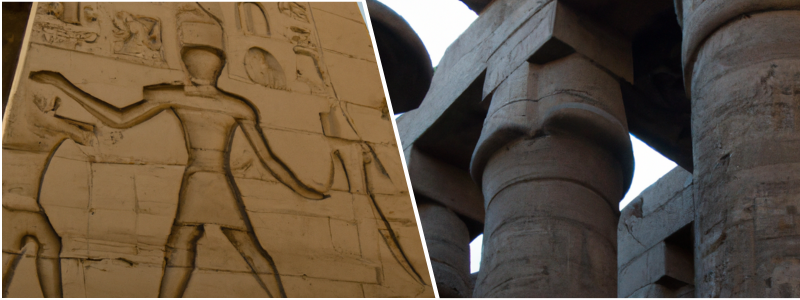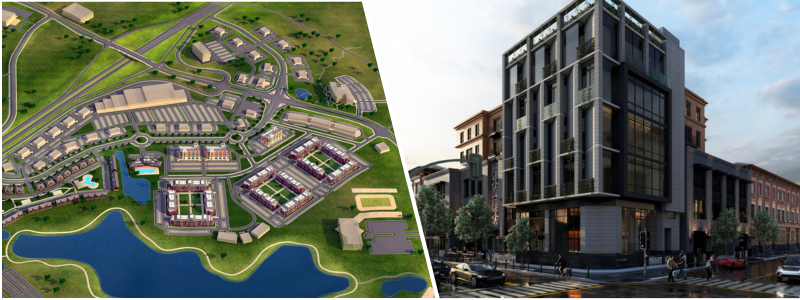Various forms of architecture have existed through the centuries. Thanks to architecture that works almost similar to signatures or footprints, contemporary archaeologists were even able to pinpoint and discover some civilizations. From the times of the Egyptian Pharaohs to this very day, architects tell distinct stories that everyone can understand. Their stories are filled with space, materiality, texture, light, and more.
3D architectural rendering services have been the unique language between designers and clients. If this tangible common ground existed, the work of an architect would have been evaluated based on mere numbers written on ledgers. This piece delves into the progression of 3D architectural rendering technology for firms in the business world.
 Table of Contents
Table of Contents
The early days
The Egyptians, Greeks, and Romans have always been considered the true pioneers of architecture. These civilizations were responsible for constructing some of the world’s most ambitious and mystical wonders using ancient technology that humankind is still trying to decipher after thousands of years.
Kings commissioned most of these architectural feats, with master builders in charge of their conception and built through long years of labor and hard work. But how were these unique structures designed in the first place? How were they communicated back in the day that was different from the method used in modern times?
It’s easy to imagine pyramids growing out of the great span of the desert out of the blue or that ancient aliens were responsible for all the out-of-this-world early achievements in engineering and architecture. Although there’s no way to know if aliens exist and if they helped with these achievements, one thing is sure: long hours of designing, planning, and strategic execution were required for these structures to be formed as they are seen today.
There’s no surprise there. After all, ancient designers and architects likely used the same methods to communicate their ideas as those used now, albeit these were more primitive. Like the great artists of the past, architects experimented with various mediums and pigments to develop aesthetics that met their rulers’ requirements and desires.

It was long before perspective was discovered to represent realism, meaning reliefs and drawings were flat back then and lacked experiential properties. Things were the same with the Romans and Greeks. The field of architecture itself has enjoyed advancements just as the sophistication of expression and design and technological innovations have also made significant leaps. However, the planning and presentation of speculative buildings only evolved a little, even if hundreds of years had passed between them.
During this point in history, architects were considered artists by trade, but the only difference was that their artworks were real and tangible. You can trace the history of 3D architectural rendering technology if you follow the evolution of fine art itself. Techniques became better and more realistic, although they remained rooted in Egyptians’ exact flat representation. What’s even more impressive is that they were able to achieve all their feats if you consider that they lacked in terms of representational limitations.
RELATED: What are architectural rendering costs, rates, and pricing for companies?
The rise of new perspectives
It was not until after 1,500 years that Italians made one of history’s most crucial discoveries. Filippo Brunelleschi, a Renaissance man, left the world in awe when he painted the first-ever example of linear perspective. It was a 3D depiction that used converging lines to represent how the human eyes see the world visually.
Brunelleschi is a name that rings a bell because of his world-renowned dome in Florence. Together with his contemporaries, Brunelleschi found the foothold that architects and artists had long been looking for: the mathematical solution that aims to grasp a realistic 2D depiction of the actual 3D world.
Although there are still heated debates on whether Brunelleschi initially discovered the perspective, he became the pioneer behind its application in architectural analysis. The rest of the artists followed suit only a short time later. The era of the Italian Renaissance marked the first significant breakthrough humanity has seen as far as 3D architectural visualization services are concerned.

Perspective incorporated space and depth into drawings and paintings. Finally, architects could develop realistic portrayals to communicate and express their majestic designs. This helped them convince their clients or the government better regarding their validity. Sketches replaced the time-consuming and expensive models and sculptures, saving precious money and valuable time.
The start of the modern times
Only after 500 years did 3D visualization services see another significant leap. The development of linear perspective paved the way for all kinds of paths that gave architects, artists, and engineers the right visual tools to help them bring their designs to life. It also helped sustain their profession for many centuries.
However, a monumental shift occurred at the turn of the 20th century. Originating with the Bauhaus during the 1910s, the modern architecture movement took architectural rendering to newer and more exciting places. During this era, architects were no longer master builders as they became a more specialized group. Their efforts were then focused on the tectonics and expression of crafting space. Space and form became their main design tools that left behind uncalled-for flair and ornamentation.
While the architectural field shifted to a plain geometric assembly of volumes and lines, 3D architectural rendering followed suit. Historic designers like Le Corbusier and Walter Gropius were the finest in expressing design details in once-impossible ways.
The three-dimensional spaces were color-coded and overlapped, leading to diagrammatic portrayals that spoke about the experience and program without just drawing it realistically. The architects also developed visual tools that helped others understand not only the “what” but even the “how” and the “why.” It’s like the curtain was finally pulled back, allowing the layman to see space in the same way as architects did.
The rest of the architects soon followed the trend. The revolution in communicating design changed how clients perceived their projects and served as a critical turning point in the field of architecture itself. Louis Kahn and Frank Lloyd Wright worked on the designs of structures that suspended disbelief, taking architecture to greater heights than it enjoyed during antiquity. Buildings soon restored their importance partly because of the new methods of conception of designs.
RELATED: What are architectural 3D visualization costs, service fees & rates for companies?
The demands of the present day

The present day is filled with Steve Wozniak, Steve Jobs, and Bill Gates. The swift advancements in computer technology in the past three decades have given the architectural world a whole new life. The capabilities of 3D architectural rendering technology made it easier for architectural design experts to present their work. They made the architectural business more efficient in one way or another, and the rest of the world had no choice but to keep up
But of course, it may mean it was challenging for people to adapt. There are still and possibly always will be several ambitious young architects and designers who live beyond the walls of the digital fortress. Architectural sketch design services and architectural drawing services continue to be critical elements of the architectural process and an essential tool for presenting conceptual ideas of their designs during the early stages. In one way or another, technology stomps on the ability of an architect to properly develop their ideas and points directly to the finish line even before the completion of the race.
It doesn’t matter which group you belong to. Undoubtedly, computer technology has had a historic impact on design communication. Artists and architects can smoothly transition between concrete and concept, which makes refinement in designs more of a trial and trial than anything else.
Different programs, including SketchUp, VRay, Rhino, AutoCAD, Mental Ray, and Maxwell, are the latest tools that empower designers and dazzle clients with on-demand results. This may pose a danger to the design’s integrity, but with the rigor and discipline that successful architects of the past have displayed, it would be easier to sidestep these risks.
RELATED: Learn about architectural design fee schedules, rates, and pricing for architect firms’ costs
What does the future hold?
Time is the only thing that can tell how 3D architectural rendering technology will be in the next 100 years. With the continuous progress of technology, the 3D architectural design process will become more reliant and dependent on automated processes. Machines may soon gain control over things, posing the risk of losing the sense of humanity in design and architecture. Like other fields, architecture may clash with technology, leading to something good or bad.
How Cad Crowd can help
As 3D rendering technology evolves, businesses and firms can stay ahead using Cad Crowd’s platform to connect directly with skilled freelance architectural design experts. Whether navigating the challenges of automated processes or seeking expertise for upcoming projects, Cad Crowd can help find 3D architectural rendering technology professionals.
